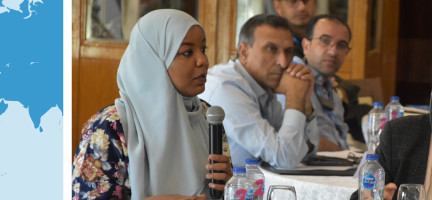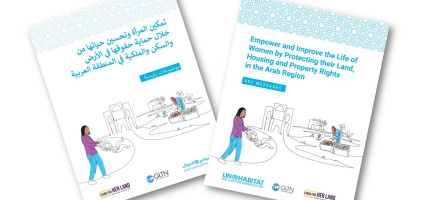Comoros
Overview
The island country of Comoros, or Union of Comoros, is located in the Indian Ocean at the northern end of the Mozambique Channel, off the eastern coast of Africa. Comoros has maritime borders with Tanzania, Mozambique, Madagascar, Seychelles and Mayotte (administered by France). These volcanic islands form an archipelago of just over two thousand square kilometers with a population of less than a million, 30 percent of which live in urban centres. The capital and largest city is Moroni on Grande Comore Island, while Anjouan Island is the most densely populated.
Legal and institutional framework
Land is governed by a mix of legal traditions: customary practices, Islamic law (Shafi’i school) and civil law derived from the French civil code introduced during the colonial area [1]. Such legal pluralism is reflected in the land vocabulary used to describe land tenure arrangements, which incorporates concepts and terms derived from Comorian Swahili, Arabic, and colonial French [2].
Land management has been traditionally based on customary norms, according to which the head of the family is considered the ‘owner’ of the land at the family level, while the village chief is the ‘owner’ at the village level [1].
During colonial times, customary land rights were utterly disregarded. A plantation-based economy was established and a third of the land was set aside for export agriculture. Farmers were dispossessed from fertile agricultural lands to the benefit of traders, colonial and urban elites; only uncultivable lands such as steep peaks were reserved for the peasants [1].
In the aftermaths of independence, obtained in 1975, this situation became unsustainable. From 1975 to 1978, workers occupied former colonial estates, and all land records, including registers of land ownership rights and a large part of the documents that were filed by the Cadastre and Domains services, were destroyed in large bonfires [2].
The Comoros attempted to address such situation by nationalising agricultural lands, introducing land reforms, and scaling up land titling [2]. Land reform proposals were made, aiming at recognising the diverse communal land tenure and land management arrangements existing on the ground, while allowing land registration and privatisation, and enabling the exploitation of the land-based resources [10]. However, due to technical challenges and political instability, the implementation of such interventions was unsuccessful, and less radical, more gradual solutions had to be considered [1]. In the 1990s, interventions to improve the productivity of small family farms were introduced, shifting the primary focus away from land registration and land reforms [5].
Land management practices at the local level differ from one locality to another. A wide range of communal arrangements and land use rights, such as sharecropping, grazing rights and leasing practices, is found. Communal land use management arrangements apply to agricultural, pastoral, fishing, and forestry activities [1].
Matrilineal inheritance practices related to land and housing are common, similarly to many Bantu tribes, although there are significant differences between the islands and variations exist among communities.[12]
Land tenure
A web of land tenure traditions can be found in the Comoros.
The statutory land tenure categories include public and private lands and properties. The public lands and properties are part of the State's domain. The State’s domain is divided into public domain and private domain. The public domain of the State includes all lands and properties classified for public use. The state’s private domain includes the lands and properties that are titled in the name of the state and its institutions or local authorities, and they do not pertain to the commons, nor do they come within the scope of community ownership [2].
Private properties are registered in the name of private individuals. Properties with a tittle deed are however few (1,412 in February 2012) and rarely put on the market. Registering private properties is extremely expensive and the process of obtaining land titles is very cumbersome [1].
Further, a large share of public and private properties is de facto communally managed [2].
The most common types of communal land tenure are uswayezi, manyahuli and nabi. In such customarily inherited usage rights’ lands, decisions are taken by all the eligible community members, or by differently composed groups of individuals, depending on the issue being deliberated on [5].
Uswayezi lands consist of the territories of the former sultanates that were made available for use to the Sultan’s subjects. They are now within sphere of influence of the local district (chef-lieu) at the micro-regional level. Conflicts between these customary grazing, forestry and tree growing rights and the land use decision taken by the State’s technical departments often arise on such lands [5].
Manyahuli lands are properties inherited through matrilineal lines; they are indivisible and inalienable, unless for exceptional reasons and with the approval of rights’ holders. These lands are generally managed by maternal uncles and protect women’s land tenure security and autonomy, particularly when dwellings for the daughters are built on it. Although not party to the matrilineage, men often farm manyahuli land [5]. Unfortunately, the investments on such lands and the maintenance of structures if at time insufficient.
Nabi properties are lands already appropriated, escheated, or temporarily managed by the village authorities before being reallocated to those in need of land. Their management remains under the control of the village community. As the beneficiary of a collective decision, the recipient of nabi lands needs to be respectful of the community's views on farming and land management. Although they also constitute individual land tenure arrangements, nabi properties are different from milk lands, because they imply reciprocal obligations by the community and the owner, who should ensure continuity in terms of land use [5].
Waqf lands, or Islamic religious endowment lands, are generally adjacent to a mosque or a madrasa, are inalienable and managed through leases. These religious holdings, generally known in Islamic law as habous, are used for charitable purposes but at time also encompass less pious practices and their management is often closer to the one found in other types of communal land [5].
Publicly owned land that has been undisputedly occupied for thirty years can be claimed through adverse possession, although the type of ownership that derives from this process is not ‘absolute’. Similarly, milk lands (or private land under Islamic law) constitute an individual private land tenure arrangement, but it is not ‘absolute’, because milk lands can only be transferred under conditions assessed locally, which reduces the owner’s discretion on sales [5].
The process for the transfer of ownership is comparable in all the three coexisting legal systems, and the concerned parties can submit contracts through the system of their choice. With regard to land and properties’ inheritance, Comorians usually apply Islamic land law, except in the case of manyahouli property [4]. The Constitution of Comoros 2001 (rev. 2009) guarantees property rights, and land cannot be expropriated except in cases of public utility or necessity determined in accordance with the law and subject to just compensation [6].
Land use
Population growth and the lack of cultivable areas are causing pressure on the environment and the degradation of resources and ecosystems.[1] Comoros has one of the highest rates of deforestation in the world. Deforestation increased agriculture on hillsides due to land shortages, and cattle grazing has resulted in severe soil erosion and runoff that have damaged the island’s coral reef. The island’s ecosystems is damaged unsustainable land-use practices and local species are threatened by extinction [7].
More than half of the land is degraded, and erosion affects most agricultural land. Current agricultural practices reinforce soil degradation (burning, fertilizers, etc.). The increase in temperature, the prolongation of drought periods, the change in rainfall patterns, sea level rise, and ocean acidification increase the vulnerability of households and the emergence of new pests has been observed [6].
The Union of Comoros has ratified several Multilateral Environmental Agreements, particularly the post-Rio conventions, and committed to a Strategy for Accelerated Growth and Sustainable Development (SCADD) for 2015/2019. It also adhered to the United Nations Convention to Combat Desertification and receives FAO’s support to manage and restore degraded lands and forests [1 and 6].
Land dispute resolution
The dysfunctionalities of the land administration system create the preconditions for numerous land disputes, which affect the development of the country’s rural and urban environment. The formal court system, independent from the executive and legislative power, deals with all disputes, including those related to land. The justice sector struggles to deal with the large number of land-related conflicts, particularly those between farmers and the state and those related to large landholdings by wealthy Comorian and foreigners [1]. However, most disputes are settled by village elders, kadis or civilian courts. Traditional practices for claiming land rights – such as the so called ‘tree tenure’ – are increasingly inadequate to respond to contemporary land management needs, fueling disputes [11].
Key interventions
Since 2012, UN-Habitat supported the Union of Comoros with policy making and projects related to urban resilience, urban planning, and post-disaster recovery. UN-Habitat works directly with the Direction Générale de la Sécurité Civile (DGSC), for matters related to disaster risk management and climate change adaptation, and with the Ministère de l’Aménagement du Territoire, de l’Urbanisme, chargé des affaires Foncières et des Transports et des Terres de l’Union (MATUAFTT), as per a Memorandum of Understanding signed in 2020. Since 2017, partnerships with two local authorities were developed to implement the Plan d’Aménagement du Grand Moroni and the City RAP programme for resilient urban planning [3].
The IFAD-supported National Programme for Sustainable Human Development (2007-2014) strengthened governance and land management at the local and community level, piloted land tenure security approaches, and supported the rehabilitation of land for environmental conservation, agricultural production, livestock and artisanal fishery. Women's access to land was prioritized, including through political dialogue [9].
References
[1] Bourhane, H. (2021). Land dynamics for rural development in Anjouan (Comoros). European Academic Research. Vol. IX, Issue 9.
[3] Diedhiou, M. (2012). Cadre De Politique De Réinstallation involontaire. Final Report of the Ministry of Finance, Budget and Investments of the Union of Comoros.
[4] Saïd, M. (2013). Pour le développement durable, l’exigence d’une refondation du droit: Éclairage à partir d’une recherche sur le foncier. Post-Doctoral dissertation, Université des Comores.
[5] Gast, M (ed.). (1987). Hériter en pays musulman: Habus, lait vivant, manyahouli. Marseille: CNRS.
[7] United Nations Development Programme. (2012). Mohéli Marine Park, Comoros. Equator Initiative Case Study Series. New York, NY.
[8] Le Roy, É. (1991). “Une doctrine foncière pour l’Afrique rurale de l’an 2000.” In L’Avenir des tiers mondes, edited by Michel Beaud and Michel Vernières, 193–211. Paris: Presses Universitaires de France.
[9] IFAD (2014). National Programme for Sustainable Human Development (PNDHD).
[10] Saïd, M. (2009). Foncier et société aux Comores: Le temps des refondations. Paris: Karthala.
[11] Saïd, M., and Sibelet, N. (2004). So that the land no longer hides the tree: the land of the tree. Anjouan.
[12] Walker, Iain. "Becoming the Other, Being Oneself: Constructing Identities in a Connected World." Cambridge Scholars Publishing. 2010.
Disclaimer
The information contained in this page is based on the body of knowledge developed by UN-Habitat, GLTN and the Arab Land Initiative’s partners. The designations employed and the presentation of the material do not imply the expression of any opinion whatsoever on the part of the Secretariat of the United Nations concerning the legal status of any country, territory, city or area, or of its authorities, or concerning delimitation of its frontiers or boundaries, or regarding its economic system or degree of development. The information may contain inaccuracies due to the data source(s) and do not necessarily reflect the views of UN-Habitat or its governing bodies.
The Comoros page is still under construction. Share with us any relevant information, resource or correction to enrich our library. Contact the Arab Land Initiative at unhabitat-arablandinitiative@un.org !




